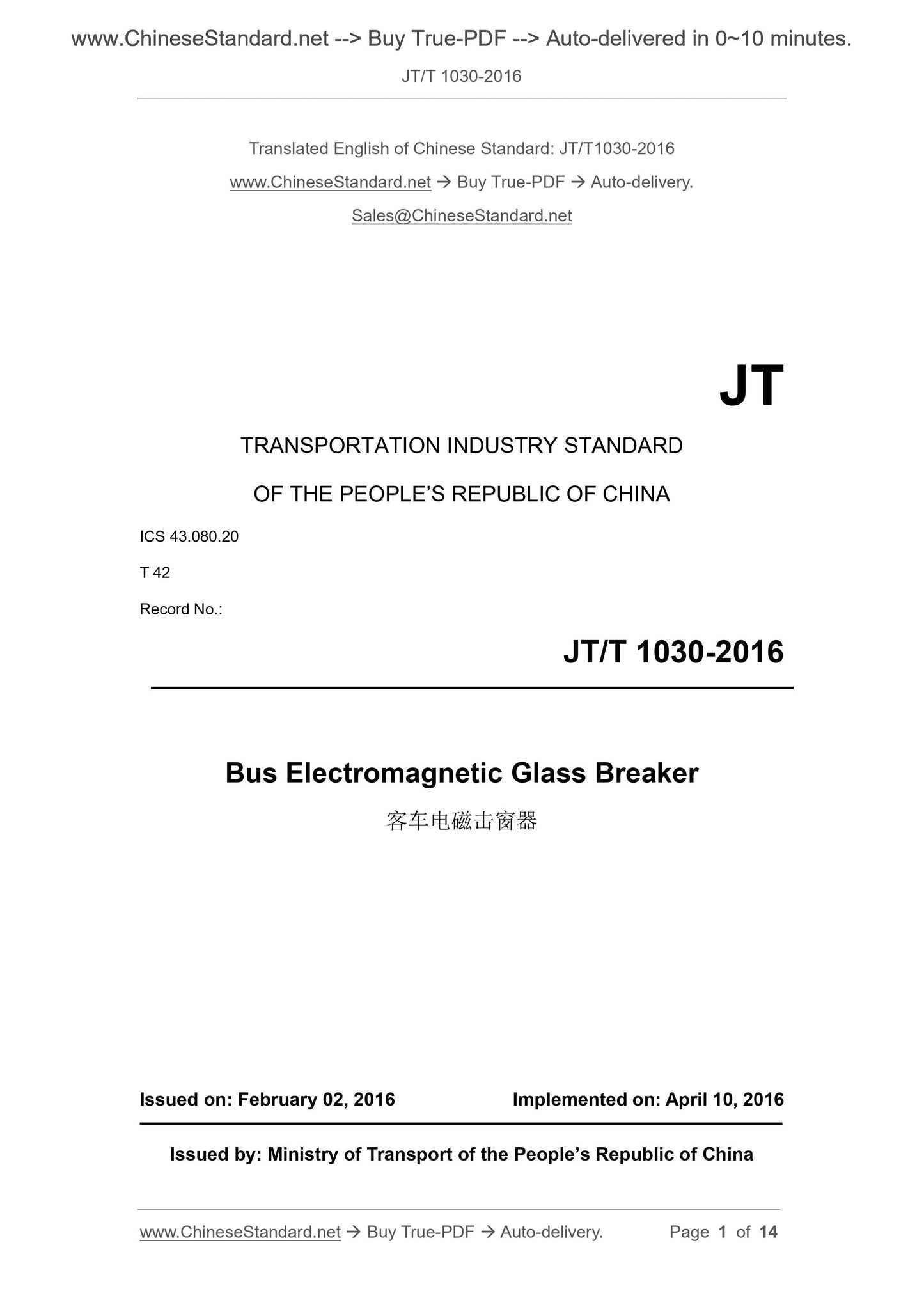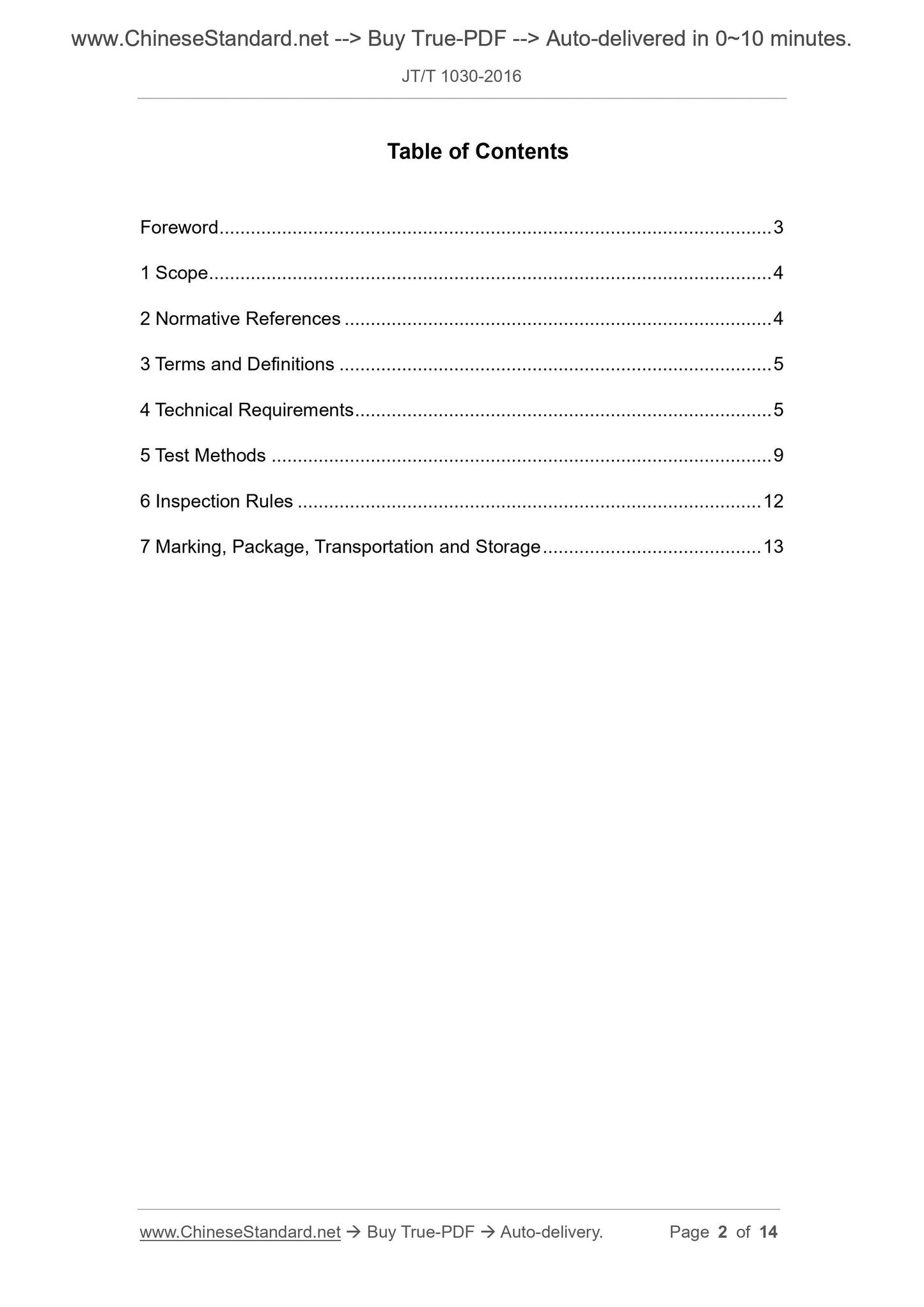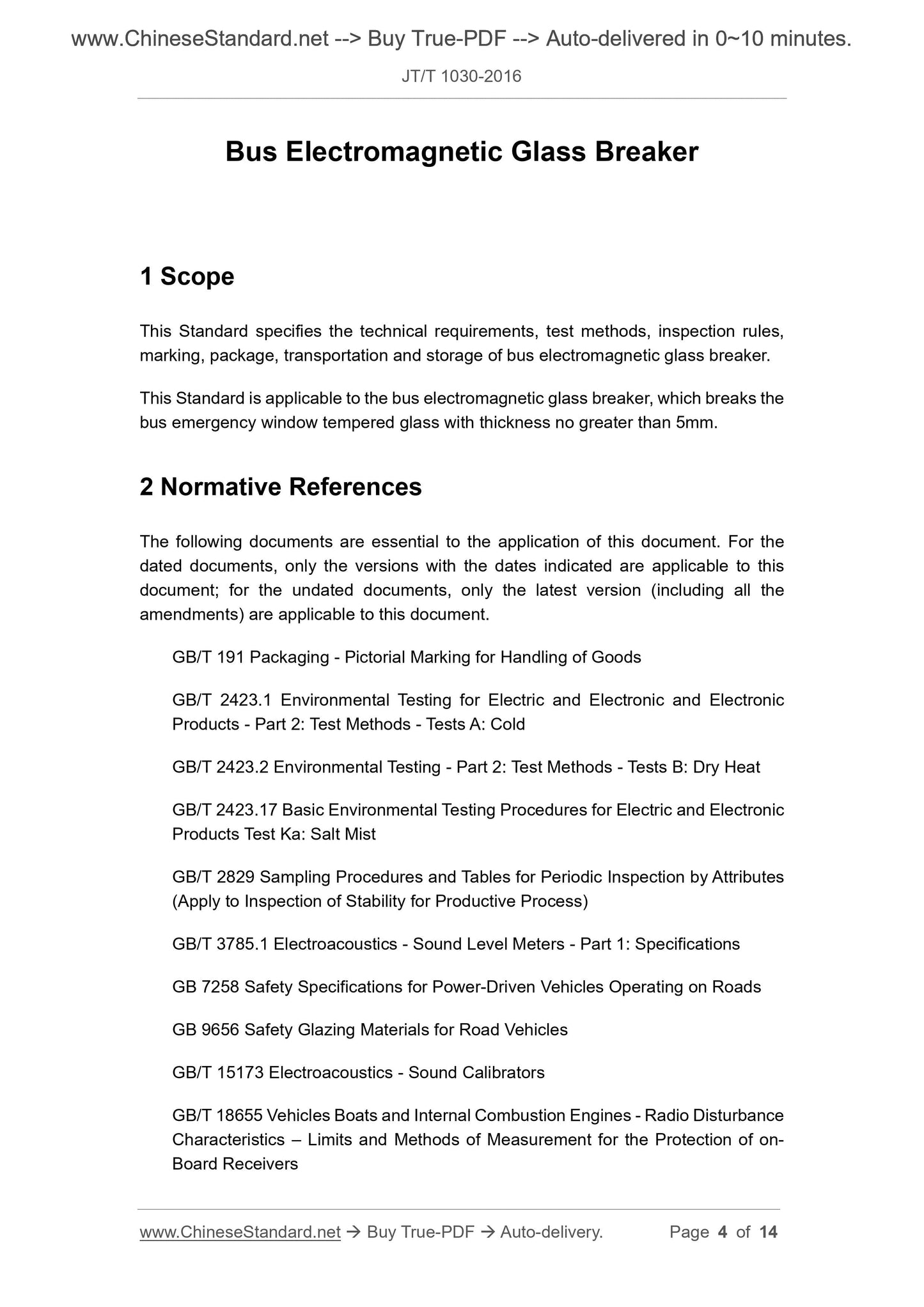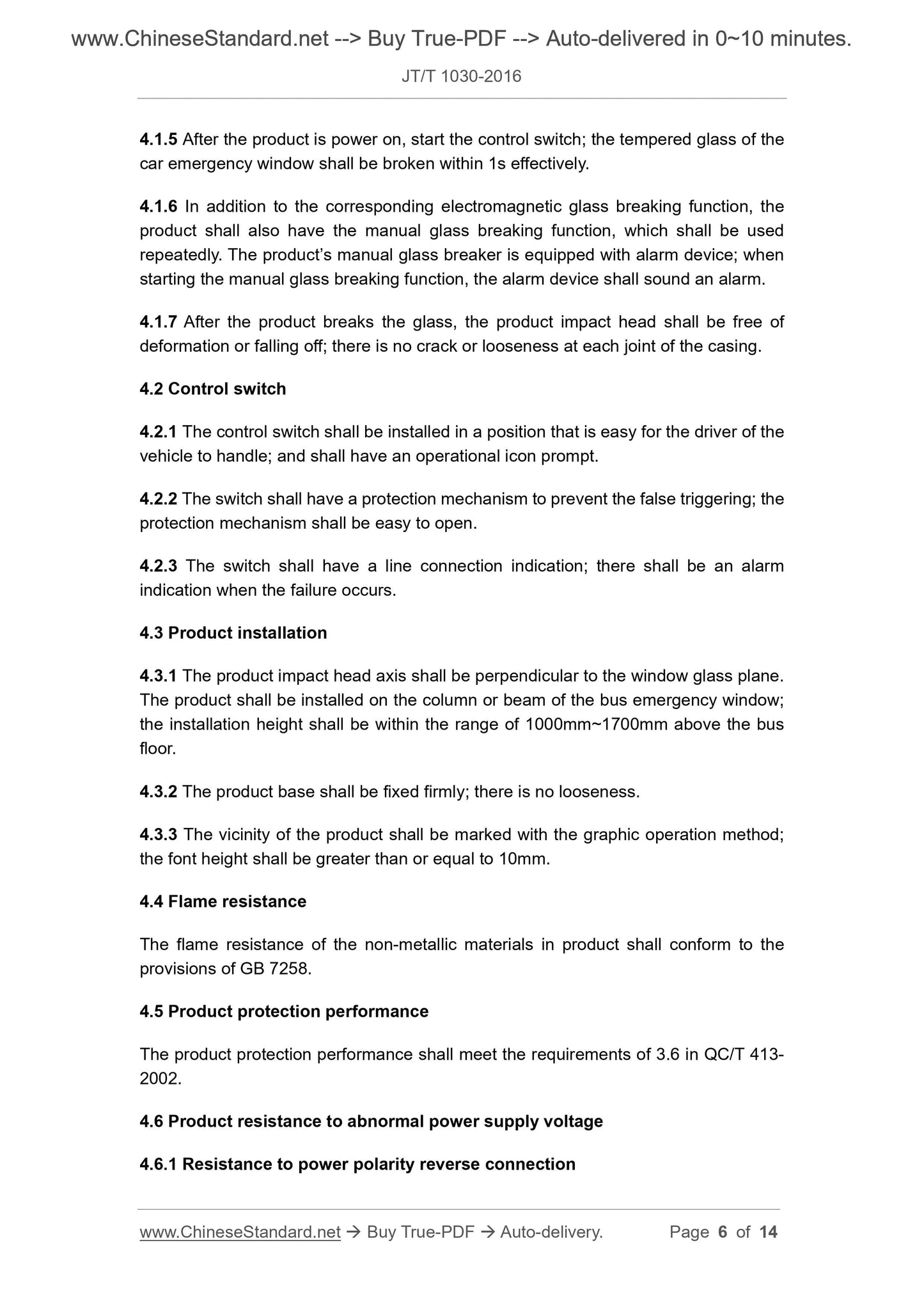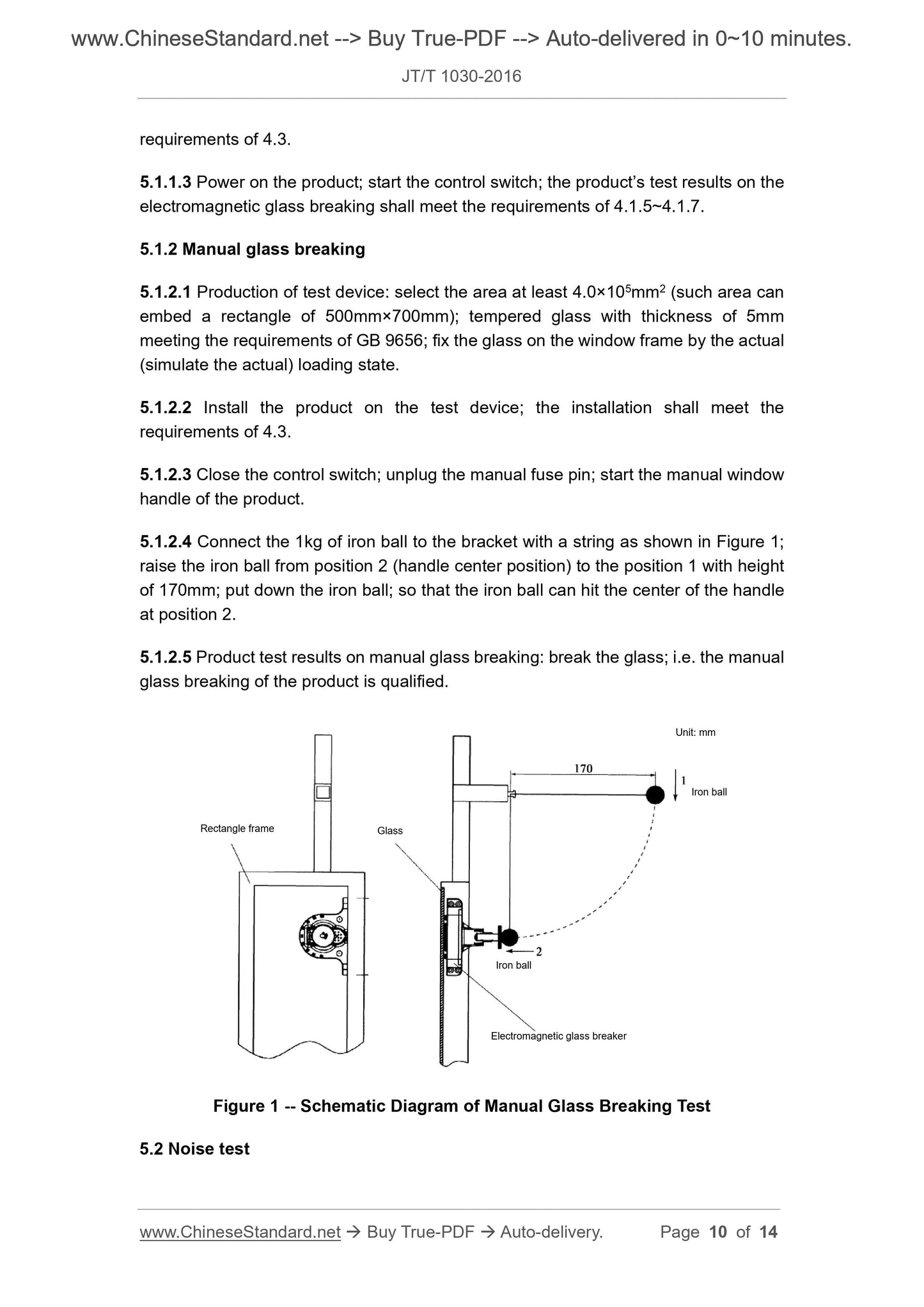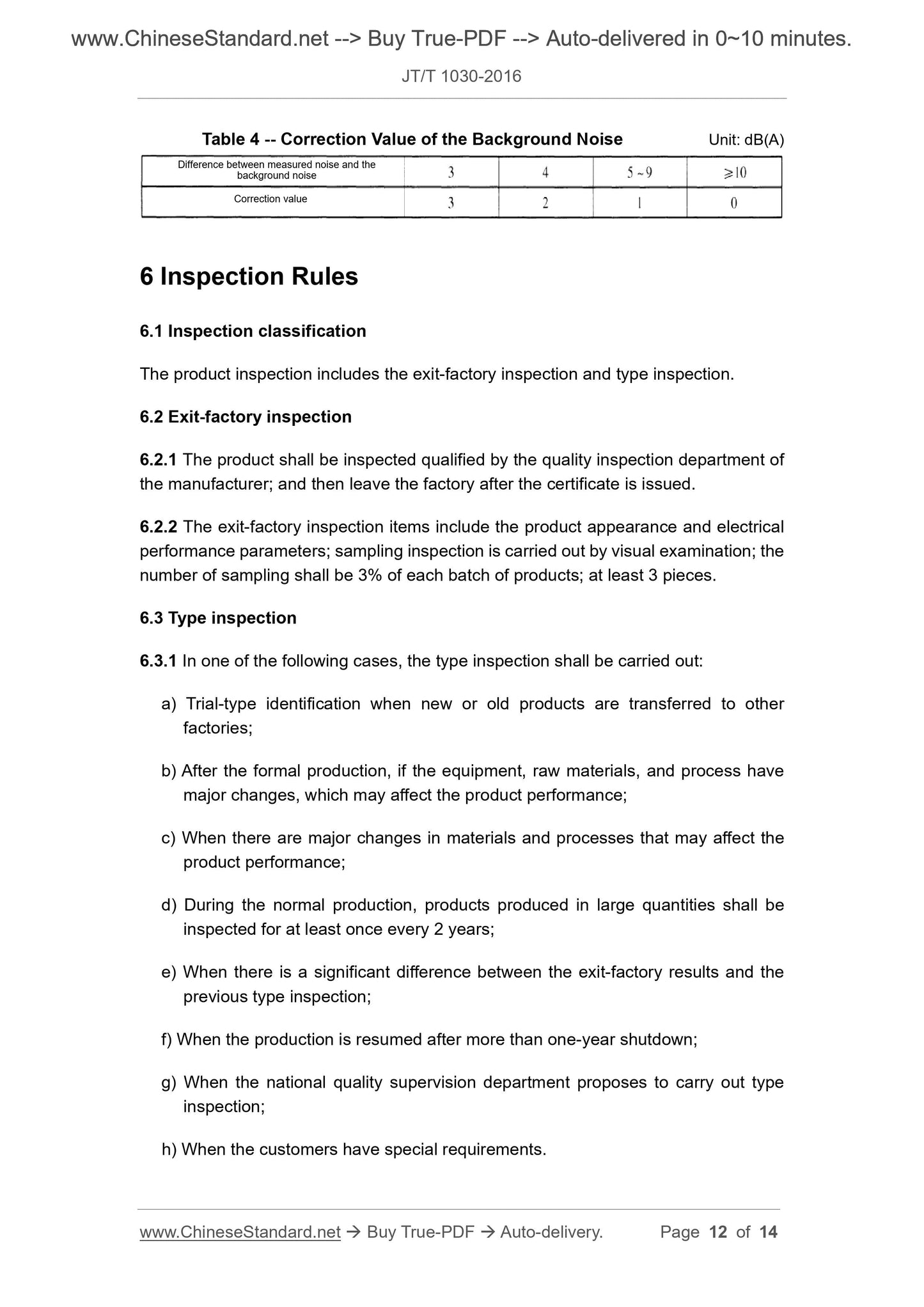1
/
of
6
PayPal, credit cards. Download editable-PDF and invoice in 1 second!
JT/T 1030-2016 English PDF (JT/T1030-2016)
JT/T 1030-2016 English PDF (JT/T1030-2016)
Regular price
$85.00 USD
Regular price
Sale price
$85.00 USD
Unit price
/
per
Shipping calculated at checkout.
Couldn't load pickup availability
Delivery: 3 seconds. Download true-PDF + Invoice.
Get QUOTATION in 1-minute: Click JT/T 1030-2016
Historical versions: JT/T 1030-2016
Preview True-PDF (Reload/Scroll if blank)
JT/T 1030-2016: Bus electromagnetic glass breaker
JT/T 1030-2016
JT
TRANSPORTATION INDUSTRY STANDARD
OF THE PEOPLE’S REPUBLIC OF CHINA
ICS 43.080.20
T 42
Record No..
Bus Electromagnetic Glass Breaker
ISSUED ON. FEBRUARY 02, 2016
IMPLEMENTED ON. APRIL 10, 2016
Issued by. Ministry of Transport of the People’s Republic of China
Table of Contents
Foreword ... 3
1 Scope ... 4
2 Normative References ... 4
3 Terms and Definitions ... 5
4 Technical Requirements ... 5
5 Test Methods ... 9
6 Inspection Rules ... 12
7 Marking, Package, Transportation and Storage ... 13
Bus Electromagnetic Glass Breaker
1 Scope
This Standard specifies the technical requirements, test methods, inspection rules,
marking, package, transportation and storage of bus electromagnetic glass breaker.
This Standard is applicable to the bus electromagnetic glass breaker, which breaks the
bus emergency window tempered glass with thickness no greater than 5mm.
2 Normative References
The following documents are essential to the application of this document. For the
dated documents, only the versions with the dates indicated are applicable to this
document; for the undated documents, only the latest version (including all the
amendments) are applicable to this document.
GB/T 191 Packaging - Pictorial Marking for Handling of Goods
GB/T 2423.1 Environmental Testing for Electric and Electronic and Electronic
Products - Part 2. Test Methods - Tests A. Cold
GB/T 2423.2 Environmental Testing - Part 2. Test Methods - Tests B. Dry Heat
GB/T 2423.17 Basic Environmental Testing Procedures for Electric and Electronic
Products Test Ka. Salt Mist
GB/T 2829 Sampling Procedures and Tables for Periodic Inspection by Attributes
(Apply to Inspection of Stability for Productive Process)
GB/T 3785.1 Electroacoustics - Sound Level Meters - Part 1. Specifications
GB 7258 Safety Specifications for Power-Driven Vehicles Operating on Roads
GB 9656 Safety Glazing Materials for Road Vehicles
GB/T 15173 Electroacoustics - Sound Calibrators
GB/T 18655 Vehicles Boats and Internal Combustion Engines - Radio Disturbance
Characteristics – Limits and Methods of Measurement for the Protection of on-
Board Receivers
4.1.5 After the product is power on, start the control switch; the tempered glass of the
car emergency window shall be broken within 1s effectively.
4.1.6 In addition to the corresponding electromagnetic glass breaking function, the
product shall also have the manual glass breaking function, which shall be used
repeatedly. The product’s manual glass breaker is equipped with alarm device; when
starting the manual glass breaking function, the alarm device shall sound an alarm.
4.1.7 After the product breaks the glass, the product impact head shall be free of
deformation or falling off; there is no crack or looseness at each joint of the casing.
4.2 Control switch
4.2.1 The control switch shall be installed in a position that is easy for the driver of the
vehicle to handle; and shall have an operational icon prompt.
4.2.2 The switch shall have a protection mechanism to prevent the false triggering; the
protection mechanism shall be easy to open.
4.2.3 The switch shall have a line connection indication; there shall be an alarm
indication when the failure occurs.
4.3 Product installation
4.3.1 The product impact head axis shall be perpendicular to the window glass plane.
The product shall be installed on the column or beam of the bus emergency window;
the installation height shall be within the range of 1000mm~1700mm above the bus
floor.
4.3.2 The product base shall be fixed firmly; there is no looseness.
4.3.3 The vicinity of the product shall be marked with the graphic operation method;
the font height shall be greater than or equal to 10mm.
4.4 Flame resistance
The flame resistance of the non-metallic materials in product shall conform to the
provisions of GB 7258.
4.5 Product protection performance
The product protection performance shall meet the requirements of 3.6 in QC/T 413-
2002.
4.6 Product resistance to abnormal power supply voltage
4.6.1 Resistance to power polarity reverse connection
requirements of 4.3.
5.1.1.3 Power on the product; start the control switch; the product’s test results on the
electromagnetic glass breaking shall meet the requirements of 4.1.5~4.1.7.
5.1.2 Manual glass breaking
5.1.2.1 Production of test device. select the area at least 4.0×105mm2 (such area can
embed a rectangle of 500mm×700mm); tempered glass with thickness of 5mm
meeting the requirements of GB 9656; fix the glass on the window frame by the actual
(simulate the actual) loading state.
5.1.2.2 Install the product on the test device; the installation shall meet the
requirements of 4.3.
5.1.2.3 Close the control switch; unplug the manual fuse pin; start the manual window
handle of the product.
5.1.2.4 Connect the 1kg of iron ball to the bracket with a string as shown in Figure 1;
raise the iron ball from position 2 (handle center position) to the position 1 with height
of 170mm; put down the iron ball; so that the iron ball can hit the center of the handle
at position 2.
5.1.2.5 Product test results on manual glass breaking. break the glass; i.e. the manual
glass breaking of the product is qualified.
Figure 1 -- Schematic Diagram of Manual Glass Breaking Test
5.2 Noise test
Unit. mm
Iron ball
GlassRectangle frame
Iron ball
Electromagnetic glass breaker
Table 4 -- Correction Value of the Background Noise Unit. dB(A)
6 Inspection Rules
6.1 Inspection classification
The product inspection includes the exit-factory inspection and type inspection.
6.2 Exit-factory inspection
6.2.1 The product shall be inspected qualified by the quality inspection department of
the manufacturer; and then leave the factory after the certificate is issued.
6.2.2 The exit-factory inspection items include the product appearance and electrical
performance parameters; sampling inspection is carried out by visual examination; the
number of sampling shall be 3% of each batch of products; at least 3 pieces.
6.3 Type inspection
6.3.1 In one of the following cases, the type inspection shall be carried out.
a) Trial-type identification when new or old products are transferred to other
factories;
b) After the formal production, if the equipment, raw materials, and process have
major changes, which may affect the product performance;
c) When there are major changes in materials and processes that may affect the
product performance;
d) During the normal production, products produced in large quantities shall be
inspected for at least once every 2 years;
e) When there is a significant difference between the exit-factory results and the
previous type inspection;
f) When the production is resumed after more than one-year shutdown;
g) When the national quality supervision department proposes to carry out type
inspection;
h) When the customers have special requirements.
Difference between measured noise and the
background noise
Correction value
Get QUOTATION in 1-minute: Click JT/T 1030-2016
Historical versions: JT/T 1030-2016
Preview True-PDF (Reload/Scroll if blank)
JT/T 1030-2016: Bus electromagnetic glass breaker
JT/T 1030-2016
JT
TRANSPORTATION INDUSTRY STANDARD
OF THE PEOPLE’S REPUBLIC OF CHINA
ICS 43.080.20
T 42
Record No..
Bus Electromagnetic Glass Breaker
ISSUED ON. FEBRUARY 02, 2016
IMPLEMENTED ON. APRIL 10, 2016
Issued by. Ministry of Transport of the People’s Republic of China
Table of Contents
Foreword ... 3
1 Scope ... 4
2 Normative References ... 4
3 Terms and Definitions ... 5
4 Technical Requirements ... 5
5 Test Methods ... 9
6 Inspection Rules ... 12
7 Marking, Package, Transportation and Storage ... 13
Bus Electromagnetic Glass Breaker
1 Scope
This Standard specifies the technical requirements, test methods, inspection rules,
marking, package, transportation and storage of bus electromagnetic glass breaker.
This Standard is applicable to the bus electromagnetic glass breaker, which breaks the
bus emergency window tempered glass with thickness no greater than 5mm.
2 Normative References
The following documents are essential to the application of this document. For the
dated documents, only the versions with the dates indicated are applicable to this
document; for the undated documents, only the latest version (including all the
amendments) are applicable to this document.
GB/T 191 Packaging - Pictorial Marking for Handling of Goods
GB/T 2423.1 Environmental Testing for Electric and Electronic and Electronic
Products - Part 2. Test Methods - Tests A. Cold
GB/T 2423.2 Environmental Testing - Part 2. Test Methods - Tests B. Dry Heat
GB/T 2423.17 Basic Environmental Testing Procedures for Electric and Electronic
Products Test Ka. Salt Mist
GB/T 2829 Sampling Procedures and Tables for Periodic Inspection by Attributes
(Apply to Inspection of Stability for Productive Process)
GB/T 3785.1 Electroacoustics - Sound Level Meters - Part 1. Specifications
GB 7258 Safety Specifications for Power-Driven Vehicles Operating on Roads
GB 9656 Safety Glazing Materials for Road Vehicles
GB/T 15173 Electroacoustics - Sound Calibrators
GB/T 18655 Vehicles Boats and Internal Combustion Engines - Radio Disturbance
Characteristics – Limits and Methods of Measurement for the Protection of on-
Board Receivers
4.1.5 After the product is power on, start the control switch; the tempered glass of the
car emergency window shall be broken within 1s effectively.
4.1.6 In addition to the corresponding electromagnetic glass breaking function, the
product shall also have the manual glass breaking function, which shall be used
repeatedly. The product’s manual glass breaker is equipped with alarm device; when
starting the manual glass breaking function, the alarm device shall sound an alarm.
4.1.7 After the product breaks the glass, the product impact head shall be free of
deformation or falling off; there is no crack or looseness at each joint of the casing.
4.2 Control switch
4.2.1 The control switch shall be installed in a position that is easy for the driver of the
vehicle to handle; and shall have an operational icon prompt.
4.2.2 The switch shall have a protection mechanism to prevent the false triggering; the
protection mechanism shall be easy to open.
4.2.3 The switch shall have a line connection indication; there shall be an alarm
indication when the failure occurs.
4.3 Product installation
4.3.1 The product impact head axis shall be perpendicular to the window glass plane.
The product shall be installed on the column or beam of the bus emergency window;
the installation height shall be within the range of 1000mm~1700mm above the bus
floor.
4.3.2 The product base shall be fixed firmly; there is no looseness.
4.3.3 The vicinity of the product shall be marked with the graphic operation method;
the font height shall be greater than or equal to 10mm.
4.4 Flame resistance
The flame resistance of the non-metallic materials in product shall conform to the
provisions of GB 7258.
4.5 Product protection performance
The product protection performance shall meet the requirements of 3.6 in QC/T 413-
2002.
4.6 Product resistance to abnormal power supply voltage
4.6.1 Resistance to power polarity reverse connection
requirements of 4.3.
5.1.1.3 Power on the product; start the control switch; the product’s test results on the
electromagnetic glass breaking shall meet the requirements of 4.1.5~4.1.7.
5.1.2 Manual glass breaking
5.1.2.1 Production of test device. select the area at least 4.0×105mm2 (such area can
embed a rectangle of 500mm×700mm); tempered glass with thickness of 5mm
meeting the requirements of GB 9656; fix the glass on the window frame by the actual
(simulate the actual) loading state.
5.1.2.2 Install the product on the test device; the installation shall meet the
requirements of 4.3.
5.1.2.3 Close the control switch; unplug the manual fuse pin; start the manual window
handle of the product.
5.1.2.4 Connect the 1kg of iron ball to the bracket with a string as shown in Figure 1;
raise the iron ball from position 2 (handle center position) to the position 1 with height
of 170mm; put down the iron ball; so that the iron ball can hit the center of the handle
at position 2.
5.1.2.5 Product test results on manual glass breaking. break the glass; i.e. the manual
glass breaking of the product is qualified.
Figure 1 -- Schematic Diagram of Manual Glass Breaking Test
5.2 Noise test
Unit. mm
Iron ball
GlassRectangle frame
Iron ball
Electromagnetic glass breaker
Table 4 -- Correction Value of the Background Noise Unit. dB(A)
6 Inspection Rules
6.1 Inspection classification
The product inspection includes the exit-factory inspection and type inspection.
6.2 Exit-factory inspection
6.2.1 The product shall be inspected qualified by the quality inspection department of
the manufacturer; and then leave the factory after the certificate is issued.
6.2.2 The exit-factory inspection items include the product appearance and electrical
performance parameters; sampling inspection is carried out by visual examination; the
number of sampling shall be 3% of each batch of products; at least 3 pieces.
6.3 Type inspection
6.3.1 In one of the following cases, the type inspection shall be carried out.
a) Trial-type identification when new or old products are transferred to other
factories;
b) After the formal production, if the equipment, raw materials, and process have
major changes, which may affect the product performance;
c) When there are major changes in materials and processes that may affect the
product performance;
d) During the normal production, products produced in large quantities shall be
inspected for at least once every 2 years;
e) When there is a significant difference between the exit-factory results and the
previous type inspection;
f) When the production is resumed after more than one-year shutdown;
g) When the national quality supervision department proposes to carry out type
inspection;
h) When the customers have special requirements.
Difference between measured noise and the
background noise
Correction value
Share
